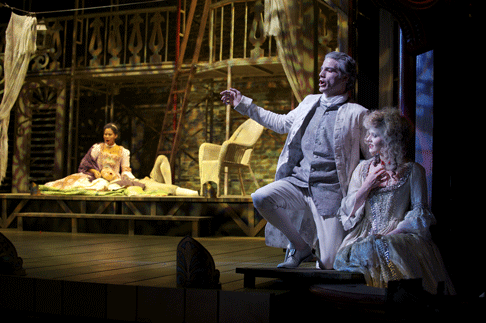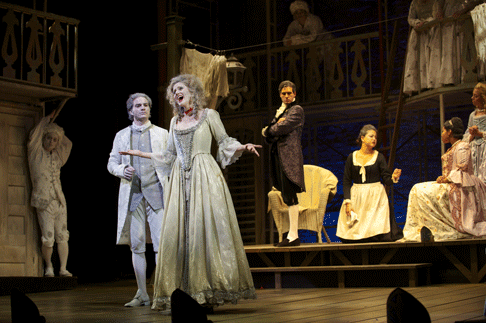The Met production journeyed to the Chicago Lyric — and then the work
disappeared. Happily, Ghosts returned to life a year ago when John
David Earnest’ s revised and trimmed-down version was premiered by the
St. Louis Opera Theater and then exported to Ireland for the festive opening of
a new house in Wexford.
Still scored, however, for 60 singers and a full-sized orchestra, the
demands made by Ghosts places the work beyond the reach of many
professional companies, while making it a field day for student opera
enterprises. Northwestern University staged the work last season, and a third
totally new production by the Aspen Opera Theatre Center brought down the
certain on the 63rd season of one of the nation’s major summer festivals
late in August. Edward Berkeley, Juilliard mentor who has directed the Aspen
Center for three decades, built the 2011 season around the figure of Figaro.
Ghosts was preceded by both Rossini’s Barber of Seville
and Mozart’s Marriage of Figaro, the first two parts of Pierre
Beaumarchais’ 18th-century account of the Almavivas. (Northwestern staged
the same “trilogy” during its past season.)
“Ghosts fits a festival well,” said Berkeley, who
directed the production, seen on August 19 in Aspen’s historic Wheeler
Opera House. “And in this context it gave students a look at how
different composers treat the same group of characters.” “It also
gave our audience a chance to compare how they have used the same
material.”
Although the reduced version — with a single intermission it runs
slightly less than three hours — contains enough plot and calls for
singers sufficient for three operas, the Aspen staging made clear that
Ghosts is a success now worthy of entering the standard repertory. The
central figure of the story is Marie Antoinette, who 200 years after she was
beheaded in the French Revolution, wants to return to life. In an
opera-within-an opera the story moves back to 1793 and offers a complex picture
of the Almaviva family, familiar from Rossini and Mozart.

For the libretto William M. Hoffman relied heavily on The Guilty
Mother, the third part of Beaumarchais’s Figaro trilogy.
But instead of merely re-writing the story Beaumarchais, author the original,
becomes the central figure of Ghosts — author, director and
major figure of the inner opera, in which he and the late Empress fall in love.
Although it is still more opera than can be absorbed in a single performance,
Ghosts is now effective and often moving theater. (Small wonder that
one heard voices in the Aspen audience express the wish to see the work
again.)
Top vocal honors in Aspen went to South-African soprano Golda Schultz, now a
student at Juilliard, who sang Rosina. Her tender duet with Korean mezzo
Chorong Kim, now — as Beaumarchais tells it — the loving father of
LÈon, was the highlight of the Aspen staging. As Beaumarchais, the man who
makes everything move in Ghosts, tall and lean bass-baritone Andreas
Aroditis, a further Juilliard student, was amazingly adept and versatile.
Christin Wismann, cover for the role in St. Louis and a member of the
supporting cast in Wexford, was a delicately tragic Marie Antoinette, an ideal
object for Beaumarchais’ affection. As ill-intentioned BegÈarss Julius
Ahn, a regular with Boston Lyric Opera, was delightfully malicious in his Aspen
debut. David Williams, a recent studio artist with Berlin’s Komische
Oper, left one with a strong desire to hear him as the “real”
Figaro, the role that he sang with such professional aplomb in the Aspen
Ghosts. And Aspen provided him with a vivacious Susanna in Kim
Sogioka, a mezzo with impressive credentials in the oratorio world. Tenor
Michael Kelly, highly regarded as a song recitalist, sang an aristocratic
— if dissolute — Count Almaviva, while Lauren Snouffer was
thoroughly engaging as his illegitimate daughter Florestine.
Major credit for the success of Aspen’s Ghosts goes, however,
to Michael Christie, who conducted both the St. Louis and Wexford performances
of the revised score. Still in his mid-’30s Christie, now music director
of the Phoenix Symphony, began his career as assistant to Franz Welser-Mˆst at
the Zurich Opera. Earlier in the summer he identified himself as a future
Wagnerian of promise in a concert with Jane Eaglen at the Colorado Music
Festival in Boulder.

Conducting an orchestra that overflowed into the Wheeler Green Room,
Christie’s total command of the score was impressive; he further showed
that rare balance of concern for both singers and ensemble under his command.
Handsome — and ghost-like — sets were by John Kasarda; lavish
period costumes were the work of Marina Reti.
Finally, Ghosts could profit from further reduction. If excised,
the entire scene built around Samira, the hoochie-cochie dancer at the Turkish
embassy bash, would not be missed — even if this was the role on which
Marilyn Horne squandered her talent at the Met.
Wes Blomster
image=http://www.operatoday.com/Figaro.gif
image_description=Sketch of Figaro by Marina Reti courtesy of the Aspen Opera Theater Center
product=yes
product_title=John Corigliano: Ghosts of Versailles
product_by=Aspen Music Festival 2010
product_id=Photos by Alex Irvin courtesy of Aspen Opera Theater Center